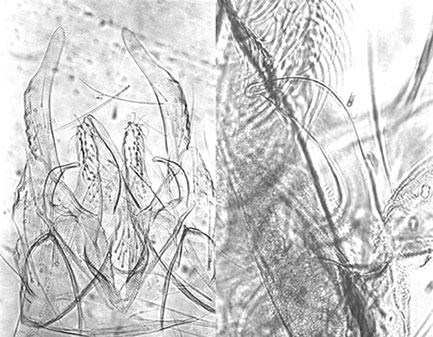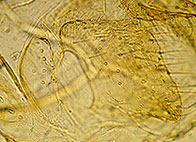Species 2g. Chironomus "butleri"
Named for Malcolm G. Butler who published a karyotype photograph.C. decorus-group species 2 - Butler et al. 1995 In BOLD Bin: BOLD:AAB7030.
C. decorus and C. quinnitukqut are also in this Bin. Adult:
Most adults of this species are in the collection of J. E. Sublette now in Museum of the University of Minnesota, St. Paul, MN.
These specimens are unavailable to me, so I propose as holotype male a reared specimen from Mississippi for which there is pupal data and also Barcode COI sequence.Similarly, the proposed Allotype female is also a reared specimen from Mississippi for which there is pupal data and Barcode COI sequence. Proposed Male holotype: (reared Mississippi specimen UMS.2.1 reared Male DNA1).
Wing length 4.0 mm. Wing width: 0.96 mm. VR 1.0. Scf on brachiolum 3, 4. Setae on squamal fringe 33 & 36. Cross vein and posterior fork slightly darkened.
Head: Antennal ratio: 3.01. Frontal tubercles developed, about 56-58 micron and 2.6 times longer than wide. Clypeus about 0.7 of diameter of the antennal pedicel, with about 29 setae.
Thorax brownish yellow with brown vittae; Setae: Achrostichal - 29; Dorsocentral - 33; Prealar - 7; Scutellar: anterior - 23 in 3 rows; posterior - 18 (total 41).Legs with darkening of the joints of the anterior tarsus and tibia.
Leg lengths (in microns) and proportions as below:
| Fe
| Ti
| Ta1
| Ta2
| Ta3
| Ta4
| Ta5
| LR
| F/T
| BR
| PI
| 1490
| 1450
| 2050
| 1065
| 800
| 680
| 325
| 1.39
| 1.03
| 3.0
| PII
| 1585
| 1440
| 920
| 510
| 360
| 270
| 190
| 0.64
| 1.10
|
| PIII
| 1661
| 1694
| 1190
| 653
| 510
| 300
| 188
| 0.77
| 1.01
|
| Note that for PI, Ta4 is shorter than Ta3 (about 85%).
Abdomen: with saddle spots on TII-VI, then whole segment darkened, about 10 setae in a single pale spot on TIX.The terminalia are essentially a typical C. decorus-type hypopygium: Superior volsella generally of the D-type, but some specimens tend to that of C. cingulatus, which Strenke (1959) classes as an E-type. Inferior volsella sometimes turning slightly out at the end and with simple setae; reaching past the end of the anal point to almost 2/3 of the gonostylus which is only moderately swollen, but narrowing significantly over posterior half to third. There is a small amount of information for a specimen from Lake Waskesui, Prince Albert National Park, Saskatchewan, in the Sublette collection. Essentially only photographs of the terminalia are available (below). This has 11 setae in a single pale area on TIX, SVo variable (as in photographs, below). Anal point relatively broad, IVo slightly turned out at the end and reaching almost to the end of the anal point and 1/3 of the gonostylus which is only moderately swollen, and narrowing significantly over posterior half to third. 
Male terminalia of C. "butleri".
A typical C. decorus-type hypopygium.Proposed Allotype Female (Jackson, Mississippi, specimen UMS.1.1. F DNA1)
Wing length abt. 4.1 mm. width:1.3 mm., VR 0.99; abt 53 setae in squamal fringe, 3 & 4 SCf on brachiolum.
Head: Frontal tubercles abt 46x23 µm (2.0 times longer than wide). Clypeus abt. 2.1 times wider than the diameter of the antennal pedicel, with about 51 setae. Antenna missing save for A1 which is 225 µm long.
Thorax: Setae: Achrostichal 17+; Humerals 5-9 in group +2-3 linear; Dorsocentrals 43 (dorsocentrals plus humerals 51-54); Prealar - 6, 7; Supra-alar 1; Scutellar 39 (21 in anterior row, 18 in posterior row).
Legs with darkening of the joints of the anterior tarsus and tibia. Leg lengths (in microns) and proportions as below:
| Fe
| Ti
| Ta1
| Ta2
| Ta3
| Ta4
| Ta5
| LR
| F/T
| BR
| PI
| 1390
| 1290
| -
| -
| -
| -
| 365
| -
| 1.08
| 1.5
| PII
| 1620
| 1490
| 860
| 430
| 340
| 235
| 180
| 0.58
| 1.09
|
| PIII
| 1730
| 1750
| 1280
| 740
| 580
| 320
| 210
| 0.73
| 0.99
|
| at least 72 SCh on hind Ta1
Most of tergites II-VIII darkenend. About 10 setae on Seg. X, which has a central oval area and extended lateral extensions, (l/w 4.7); 3 setae on GcIX. Cercus almost square but with a bulge on the ventral posterior corner.
Cercus and segment X of proposed allotype female.Larva, pupa and cytology - see C. 'butleri' immatures DNA analysis:
mtCOI: Barcode sequence shows that this species is very close to C. decorus (sp. 3a), as both are placed in BOLD Bin AAB7030. Comparison of the sequence to that of C. decorus indicated only a single base pair difference in the COI sequences, while other differences exist as polymorphisms in this species. C. quinnituqut is also in the same BOLD Bin, but here there are 13 consistent base differences between the species (with 3 of these including a low level of polymorphism for the base in the other species). Base
C. quinnitukqut
G A T T A/T G C T A A T T C
C. 'butleri'
A G C C A T T C G G C/T C A/TFound: Ontario – Cactus Field, Point Pelee Natl. Pk. (41.939°N, 82.516°W) (from GenBank)
Quebec - St. Charles River (46.82°N, 71.22°W), Quebec City; Lake Adéline (48.20°N, 79.17°W), Lake Dufault (48.28°N, 79.00°W),
Lake Duprat (48.33°N,79.12°W), Lake Fortune (48.18°N, 79.32°W), Lake Opasatica (48.17°N, 79.33°W), all Rowyn-Noranda.
Saskatchewan – Lake Waskesiu (53.92°N, 106.08°W), Prince Alfred National Park.
California – Lake Davis (abt 39.70°N, 120.50°W).
Indiana: – Crooked Lake, Angola; Lake Oneotta, Marinette(?); Shafer Lake.
Kansas – Lone Star Lake (38.83°N, 95.38°W); Natural History Reserve, University of Kansas (39.00°N, 95.42°W),
both Douglas County.
Massachusetts – Connecticut River, Northfield (42.691°N, 72.452°W), Franklin Co. and at Northampton (42.322°N, 72.638°W),
Hampshire Co.
Michigan: – Saginaw Bay (43.75°N, 83.67°W), Lake Michigan.
Minnesota: – Lake Christina (45.08°N, 95.75°W), Douglas Co.
Mississippi – Belzoni (33.17°N, 90.67°W), Humphreys Co.; Jackson (32.50°N, 90.33°W), Hinds Co.
New Mexico – Springer Lake, Colfax Co.; Frio Draw and Weber City cut-off, Curry Co.; Canadian River and Ute Lake, Quay Co.
North Dakota – Kota Ray Dam, Williams Co.; Lake Williams, Kidder Co.
Texas - Quaker Street Plaza, Lubbock (33.64°N, 101.96°W), Lubbock Co.
Vermont – White River (43.80°N, 72.45°W), nr, Sharon, Windsor Co.
Wisconsin – Booth Lake; Friebauer Lake, Bayfield Co.; Lake Oneonta, Marinette Co.; Lake Pepin, Pepin Co.; Pine Lake, Oneida Co.;
Booth Lake, Walworth Co.
Brazil. Found mostly in depths to over 10 m. in lakes.
It is possible that those from shallow habitats are actually C. decorus (sp. 3a).This is the C. attenuatus of Hilsenhoff & Narf 1968 and C. decorus-group species 2 of Butler et al. (1995), who provide a karyotype photograph. Wuelker et al. (2009) give some cytological comparisons to C. bifurcatus and C. blaylocki.
The species is closely related to C. decorus, as indicated by the the Barcode sequence, but shows differences in the chromosome banding patterns and a number of morphological characters, e.g lacks the secondary tubercle and the frontal warts of the pupa are smaller and lack a seta, while there are usually more spines on the spur (4-11 c.f. 1-6). See also C. bifurcatus, C. blaylocki, C. decorus Joh., C. harpi, C. mozleyi, C. winnelli, C. sp. b, C. sp. c, C. sp. j, C. sp. 2a, C. sp. 2b, C. sp. 3h, C. sp. 3i, C. sp. 3j.[ Return to Index ] |

